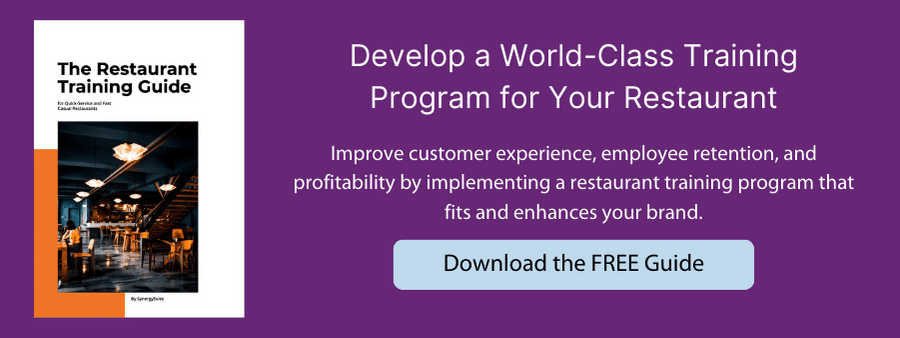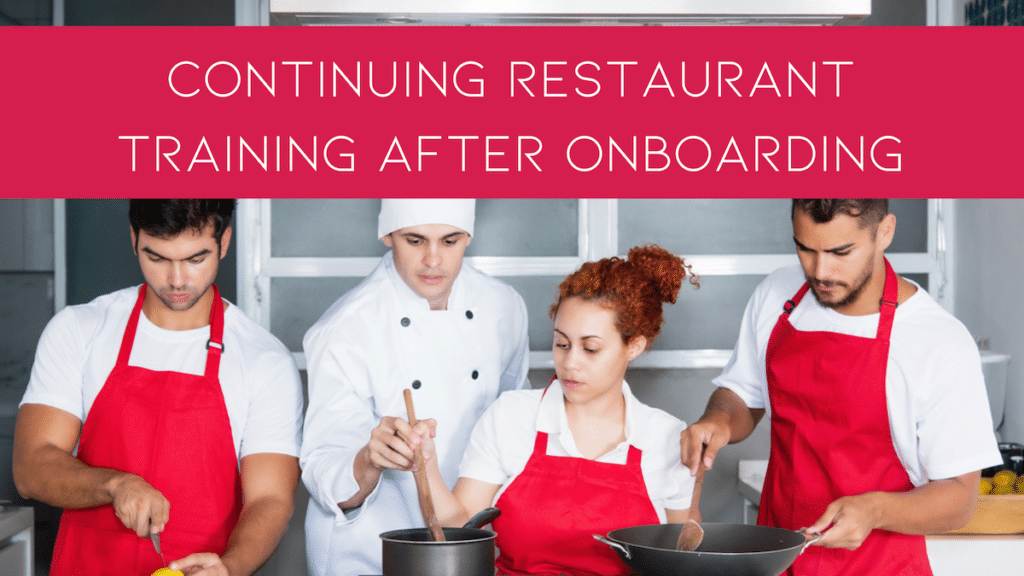Restaurant training is most crucial during restaurant employee onboarding, but shouldn’t be forgotten afterwards. After the initial training period and shadowing is complete, the most important areas of knowledge must be continuously enforced. Having a solid restaurant training program that continues on an ongoing basis can provide huge benefits to your restaurant business.

Why is Continued Restaurant Training Important?
For even the most seasoned and experienced employees, ongoing training should be a regular part of the job and can help your business continue to flourish. Here are some of the main benefits of having a consistent and ongoing restaurant training program.
Better Performance and Higher Customer Satisfaction
This one might seem like a no-brainer, since the goal of all training is to improve performance. But the biggest benefits can be in the smallest details, and ongoing training can continue to sharpen skills in every area. From improving serving and checkout speeds, to perfecting the way a meal is plated or boxed, to ensuring a consistent customer experience, your employees will continue to improve through a solid and consistent training program.
Avoid Mistakes, Errors, and Accidents
On the flip side of the performance coin, ongoing training also decreases the risk of the negative consequences of mistakes, errors, and accidents. Consistent training sessions keep safety at the top of mind, and also helps to avoid complacency and “going with the motions” that lead to slips in focus, or outright skipping steps in processes. While some mistakes and errors only have small consequences, sometimes they can be incredibly costly. Ongoing training can help to mitigate the risk of such problems.
Stay Up to Date on Industry Trends and Techniques
Even if your food and your restaurant itself generally stays the same, the restaurant industry can shift and change as much as any other industry. Having a solid, ongoing training program will give you the perfect framework for teaching and updating every employee on changes that might be going on in your industry, and how those changes will impact your process, and even your brand itself.
Make Better Use of Restaurant Technology
In addition to changes in the industry, you can be certain that there will always be changes in restaurant technology as well. Your training program should account for situations where you may need to change what technology you’re using to make employees’ jobs more efficient and easier to manage. Even if you don’t change your technology, the technology you’re already using will continue to evolve and change as well, so training and retraining on your tools is an important part of your training program.
Provide Opportunities for Employee Feedback
One of the greatest benefits to regular and formal ongoing training is that it provides clear opportunities for your employees to give you feedback on what’s working and what’s not in your restaurant business. In a fast-paced and adapting environment, it’s common for restaurant employees to find their own solutions, and work around roadblocks on their own. Sometimes you may not even hear about the issues until they become much larger problems. Having consistent training gives you the opportunity to have open communication, and correct challenges and make your employees feel seen and heard.

Best Practices for Your Ongoing Training Program
Have Consistent, Regular Training
Regular training sessions should be a part of all employees’ routines. Even seasoned employees that have been in your organization for years still have things to improve, and will still need to be trained on new systems, technology, procedures, and other updates to your business. Items that will always need a regular cadence of refresh training regardless of job role are:
- Product Knowledge: new menu items and ingredients to help answer customer questions will need to be top of mind for all employees. This training may include learning about different preparation methods, nutritional information, and any allergens or dietary restrictions that customers may have. This training can be done through in-person demonstrations, online tutorials, or through shadowing more experienced employees.
- Customer service: employees will often need refresher training on how to maintain customer service excellence and “flexing their muscles” on how to handle difficult customers, how to upsell menu items, and how to handle customer complaints. In person role-playing can often be a useful exercise to demonstrate these scenarios. It is important for staff to understand the importance of providing excellent customer service and the impact that it has on the restaurant’s overall success.
- Safety: Whether or not if you work directly in the kitchen, there are always elements of safety to consider when working in a restaurant and should always be an important aspect of routine training. Employees must be trained on safety procedures such as fire safety, slips, trips and falls, and emergency procedures. This training can include hands-on drills, online tutorials, or in-person training sessions. It is important for employees to understand the importance of safety and how to respond in case of an emergency.
- Sexual Harassment and Discrimination Prevention: All employees should be regularly trained on the restaurant’s policies and procedures related to preventing sexual harassment and discrimination in the workplace and how to report any incidents.
- Employee Hygiene: New hires should be trained on employee health and wellness policies such as hand washing, cough and sneezing etiquette, and how to stay healthy while working in the restaurant.
Incorporate Team Building
The quality and success of your restaurant locations is highly dependent on how well your teams can work together. This includes your veteran staff in addition to your new hires. Incorporate team-building exercises to help new hires integrate into your company culture and make them feel welcome.
Team building activities can help to build trust, foster communication, and increase collaboration among staff members, which can ultimately lead to improved customer service and increased productivity. The more your staff understands each other, the easier it will be for them to work together on a day-to-day basis.
Some examples of team building activities that can be implemented include:
- Games: Activities such as scavenger hunts, escape rooms, and trust-building exercises can help to promote teamwork and communication among staff members.
- Staff appreciation events: Hosting events such as employee appreciation days or staff parties can help to build camaraderie and show staff that their contributions are valued.
- Training sessions: Organizing training sessions on topics such as customer service, leadership, and effective communication can help staff members to learn new skills and improve their performance.
- Team lunches or breakfasts: Regularly scheduled team lunches or breakfasts can help to build relationships and foster a sense of community among staff members.
- Team goals: Setting team goals and encouraging staff members to work together to achieve them can also be an effective way to build teamwork and promote collaboration.
- Volunteer work: Organizing volunteer work as a team can be a great way to bond and give back to the community.
Review the Essential Topics
Continue to go over the most important topics with your new hires, and have your long-time employees share their experience and knowledge with the team. Some of these topics can include:
- Restaurant policies and procedures: New hires should be familiarized with the restaurant’s policies and procedures, including dress code, punctuality, break policies, and other important rules. Long term employees can share tips on short and lunch breaks to help the new employee get acquainted with how things work within the team.
- Customer service: New hires should be trained on how to provide excellent customer service, including how to handle difficult customers, how to upsell menu items, and how to handle customer complaints. Some helpful tips a long time employee can give are any regular customer requests or observations they have had.
- Teamwork and communication: New hires should be trained on the importance of teamwork and effective communication, including how to work effectively with other staff members and how to communicate with customers. Veteran staff can share the current team dynamic with new hires to help get them up to speed.
- Misc: It is also important for existing employees to share their own experiences and insights with new hires, such as how to handle stress, how to work efficiently, and how to balance multiple tasks. This can help new hires to feel more comfortable and confident in their new roles and get a better understanding of the restaurants’ culture and values that can’t be found in a training manual.
Choose Additional Topics Based On Needs
There are plenty of restaurant training topics that should be regularly reviewed and retrained on, but you’ll also want to make sure you customize your training approach to match the needs of your team. To determine what might be most valuable for your employees, let the shift and store managers provide feedback and determine what would be appropriate for their teams to review and be rained on.
Here are some of the endless topics to consider when thinking of more customized training for your restaurant:
- Food safety standards and regulations
- Cash handling procedures
- Specific skill development
- Reviewing processes, or practicing them as a team
- Training on new workflows or technologies
- Working a new employee into the usual flow of the team
- Discussing and role-playing soft skills that may be useful for job efficiency
- Having open discussions to brainstorm solutions to problems or challenges
Your continuing restaurant training program is bound to continue to evolve and adapt as new challenges arise. The effectiveness and content of your training program should be a regular topic of discussion, so that you can continue to improve your processes and training routine. A renewed focus on the training of your restaurant staff will provide huge benefits, and is definitely worth the investment.
Manage Ongoing Training with Restaurant HR Software
In today’s culture, and when working within a restaurant enterprise with many locations, you can save yourself a lot of time and effort during restaurant employee onboarding by utilizing restaurant HR software. This software can be incredibly useful for keeping updated versions of your manuals, videos, and other resources in a place that can be accessed and referenced from anywhere and at any time.
Not only that, but restaurant HR software can also help you create onboarding and training documents and checklists that will ensure that each employee is up-to-date on their training, and that no important topics are missed. This can be especially useful when you are managing the training of new employees across a large number of locations, saving your HR department a lot of time and energy in tracking the progress of each new employee.
Additional Topics for Your Restaurant Training Program
Your restaurant training program will likely cover a wide range of topics, and can be implemented in just as many ways. Check out more of our training program resources to make the most of your restaurant training program:
- Creating a Restaurant Training Manual
- Methods for Training Employees in Restaurants: Pros, Cons, and Tools
- Restaurant Employee Onboarding: How-to and Common Topics
- Role-Specific Restaurant Training in Quick-Service and Fast Casual Restaurants
- Additional Training Topics for Restaurant Employees





